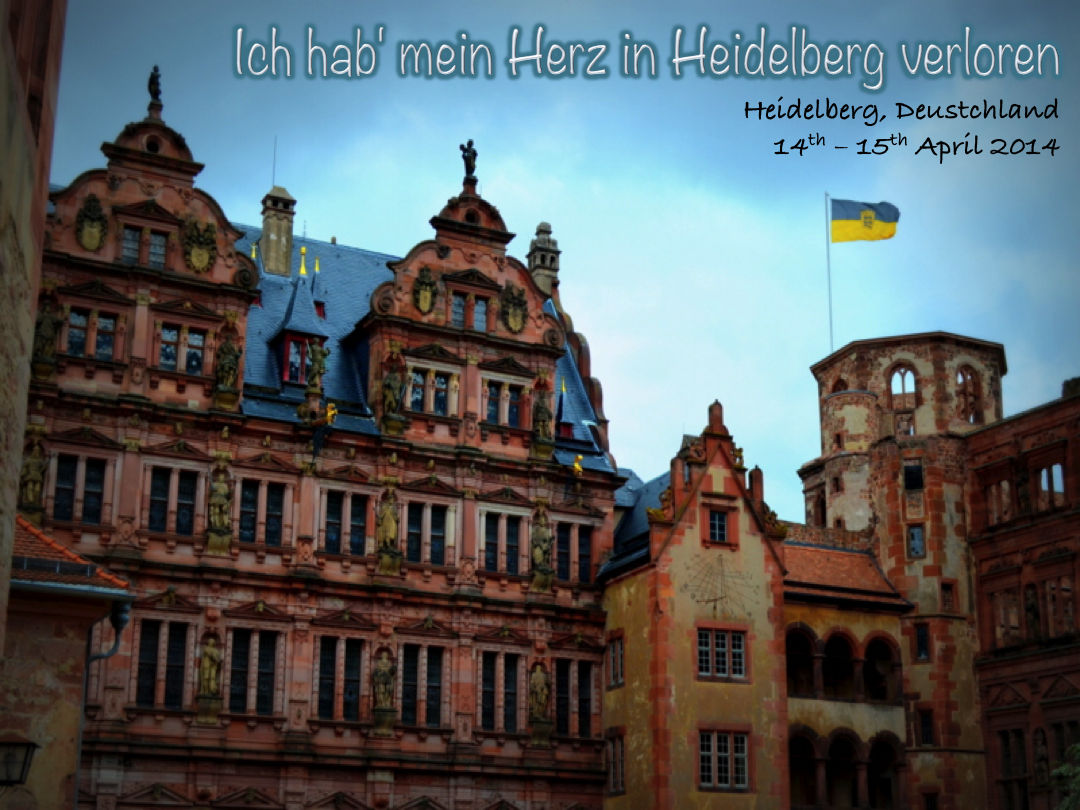Ich hab' mein Herz in Heidelberg verloren (I Lost my Heart in Heidelberg) was written in 1925 by Austrian composer Fred Raymond. This world famous song is the theme song for Heidelberg, Easter #3
It is claimed that the insanely strong winds here kept it safe (most of it at least) from the Allied bombs during WWII. The same insanely strong winds threatened to freeze me over and blow me away too. Heidelberg lies along the River Neckar and is home to the oldest university of Germany. No prizes for guessing the name of the university...Heidelberg University.
More interesting facts are that it is also "the home of the Bunsen burner” as well as the birthplace of the young Magneto, also known as, Michael Fassbender.
These are the stories of why I Lost my Heart in Heidelberg...
(Written on 29th May 2014)
Spring begins to spread throughout Philosophenweg (Philosopher's Walk). It's easy to see why professors and philosophers would take a stroll here to philosophise. The beauty of His creation engulfs the route and its peace and quietness soothes the soul.
Pondering, like a true blue Philosopher...
Across the River Neckar and on higher ground, stands the Heidelberg Castle
Looking over the River Neckar and towards Heidelberg Castle and Altstadt. I'm no philosopher but as I look at what used to be a fortress, I'm reminded that the Lord is my rock, my fortress and my deliverer; my God is my rock, in whom I take refuge, my shield and the horn of my salvation, my stronghold!
Going down by zig-zag stairs of Schlangenweg, which offers another route to Philosophenweg from the Old Bridge.
The River Neckar, that also runs past Stuttgart (and past Daimler AG) is a favourite spot for avid rowers. Despite the strong and cold winds, you can always find a couple of people rowing away.
On the Karl-Theodor-Brücke or Alte Brücke (Karl-Theodore Bridge or Old Bridge) with Heidelberg Altstadt in the background. The twin towers, or Brückentor was historically part of Heidelberg's fortifications. It was so incredibly cold and windy that morning that I needed a double scarf.
Heidelberg Castle and the statue of St Mary from Kornmarkt
From atop Heidelberg Castle, the River Neckar and Altstadt in (almost) full view
As rainclouds beginning covering the Heidelberg Castle... the sundial continues to tell time.
Just outside the museum, you could find tools they used to pound medicine in the past. It sure was heavy alright...
Robert Bunsen, the inventor of the Bunsen burner died at 88 here in Heidelberg.
By virtue of being the only photo that my buddy took with me throughout the 10 days of interrailing, this has to be here. Reminiscing the good times...
"I may be young but don't underestimate me. I will achieve great things!"
Among the greenery of Hortus Palatinus (Garden of Palatinate) with Heidelberg Castle in the background. The Baroque garden was attached to the castle and has received the status of "Germany's greatest Renaissance garden".
One of my favourite photos taken during Easter, just because of the beautiful colours.
Heidelberger Schloss (Heidelberg Castle) is Germany's famous ruin. The ruins were a result of damages to it by wars, lightning bolts and fires.
Heiliggeistkirche (Church of the Holy Spirit) is the tallest and most famous church in Heidelberg. It's also the centre of Marktplatz, Heidelberg.
Jesuitenkirche (Jesuit Church) is more renowned for its church tower but was added in 1872 only after the initial church was completed, hence the main tower was intentionally left out here.
Hauptstrasse, the main shopping street of Heidelberg is Europe's longest car free zone. Sounds like it conflicts Königstrasse of Stuttgart, but pedestrianised and car-free, apparently has a very different meaning.
Far away from the old town and close by the HBF, the sun begins to set in Heidelberg. Easter #3 is also the last city in Germany before crossing over to France. The picturesque cityscape and romantic beauty of the city is why "I Lost My Heart in Heidelberg".


